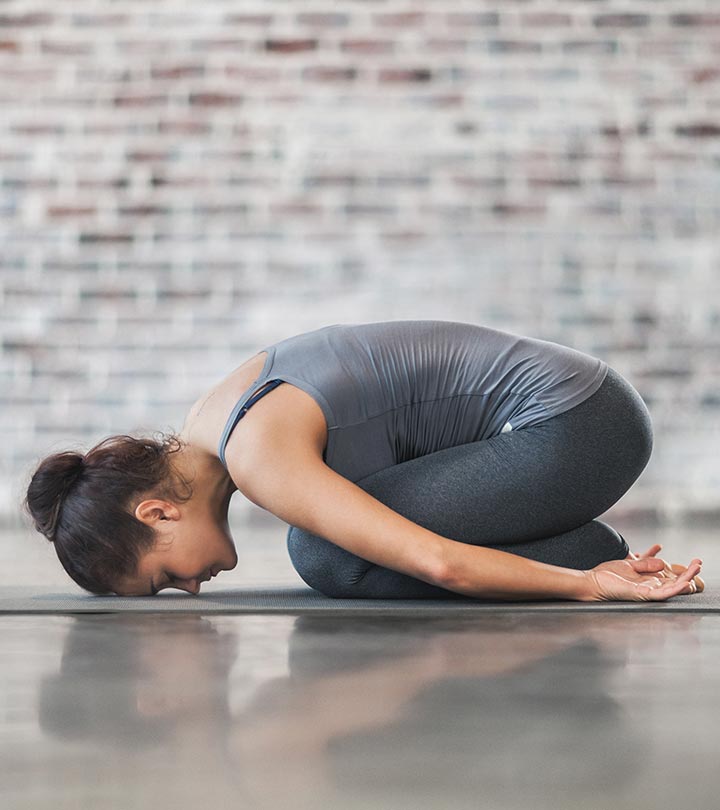Feeling dizzy in love may be pleasurable, but it can be the worst feeling in the world otherwise. If you are pregnant or inebriated, you might be able to live with it as this dizziness is temporary, but if you have vertigo, yoga will save you! In this article, we talk about all the yoga asanas to treat vertigo. Take a look!
In This Article
What Is Vertigo?
Vertigo is a disorder associated with a disturbance in the sense of balance and equilibriumi XA number of external forces acting on the body that produces no change in the state of motion or rest. in the brain, and this causes dizziness. It usually affects the area that is responsible for the direction of motion, which is the inner ear. The causes could be anything – ranging from a lack or drop in blood flow to the ear, calcium or fluid accumulation, or even due to a viral attack. Well, even a simple virus that causes cold or flu can also attack the inner ear and affect the nerve connectors to the brain, causing severe vertigo. Damage to the skull also causes a loss of hearing, nausea, and dizziness. A tumor, syphilis,i XA bacterial infection spread via sexual contact which causes genital and oral sores and nerve, brain, or heart damage. or multiple sclerosisi XA chronic condition that directly affects the protective covering of the nerves, disrupting brain-body communication. can also affect your sense of balance.
StyleCraze TriviaSome other common symptoms of vertigo are headache, blurred vision, ringing in the ears, feeling of being pulled, and swaying and tripping due to lack of balance.Related: Home Remedies For Vertigo And Treatment
How Does Yoga Help To Cure Vertigo?
Some yoga poses work on the nervous system and strengthen it. These poses also work on the balance centers and the inner ear, and help build concentration and focus. Yoga works on the sympathetic and parasympathetic nervous systemsi XPart of the autonomic nervous system that alerts the body to danger, resulting in increased heart rate and sweating. and increases the circulation in the head and the rest of the body.
However, during the vertigo attack, its better to rest for a time period when the severity of the malady is at its peak and wait for symptoms to subside and and thereafter start the practice. If the vertigo is BPPV (Benign Paroxysmal Positional Vertigo), it would be sensible to go in the postures very slowly and avoid any jerky actions, especially with the neck and head.
Related: 7 Exercises For Vertigo You Can Do At Home (With Pictures)
7 Asanas That Will Help You Overcome A Vertigo Attack
- Balasana
- Paschimottanasana
- Viparita Karani
- Supta Baddha Konasana
- Halasana
- Salamba Sirsasana
- Shavasana
1. Balasana
Image: iStock
Also Known As – Child’s Pose
Benefits – This asana is a relaxing pose. It is meant to calm the mind and ease the pressure of the nervous system. At the onset of a vertigo attack, a restorative pose such as this will help you get a hold of your self. This asana helps to strengthen the nervous system with regular practice.
How To Do It – Come onto your fours. Now, bring the feet together as you widen your knees. Rest the abdomen on the thighs and your buttocks on the feet. Place your forehead on the ground. Bring your arms around you, alongside your legs. You can hold your feet with your palms. Hold the pose for a few minutes, and release.
To know more about this asana, click here: Balasana
Related: 10 Effective Yoga Asanas To Stimulate Your Nervous System
2. Paschimottanasana
Image: iStock
Also Known As – Seated Forward Bend, Intense Dorsal Stretch
Benefits – This asana is a great stress reliever. It helps balance emotions and relieves anger, anxiety, and irritability. It increases the blood flow in the head and the balance centers, thus helping with vertigo. Your nervous system is strengthened with this asana.
How To Do It – Assume the Dandasana. Then, stretch the arms above the head, and gently bend forward. Depending on how flexible you are, you can either touch your toes or catch your feet. Lower your head as much as you possibly can. Hold the pose for a few seconds, and then release. Make sure that you are not straining your low back or rounding your upper back.
To know more about this asana, click here: Paschimottanasana
3. Viparita Karani
Image: iStock
Also Known As – Legs Up The Wall
Benefit – This asana is primarily benefits those who have vertigo. It calms the mind and relieves headaches associated with the problem as this posture contributes to a healthy venous blood flow, allowing for greater relaxation and switching off pain receptors. Closing your eyes also helps you regain
How To Do It – Sit across a wall and raise your legs up using the support of the wall. Lie down gently and stretch out your arms to the sides, folding them at the elbows so as to resemble a cactus. Place your palms facing upwards. Once you are comfortable, close your eyes and take long, deep breaths. Release after a few minutes.
To know more about this asana, click here: Viparita Karani
4. Supta Baddha Konasana
Image: iStock
Also Known As – Reclining Bound Angle Pose
Benefits – This asana works on the centers of balance, and almost instantly reduces dizziness. It improves the blood circulation throughout the body, including the head. It is also an extremely comforting pose that calms your nerves and your mind.
How To Do It – Lie on your back. Bend your knees, and bring your feet together, thereby opening up your legs on the side. Raise your arms above your head. Relax. Release when you are satisfied.
5. Halasana
Image: iStock
Also Known As – Plow Pose
Benefits – This asana strengthens the neck. As it does that, it works on the balance system, the inner ears, and the nervous system. It releases the stress on the nervous system and calms your mind. It helps tackle the side effects of vertigo with ease.
How To Do It – Lie on your back. Support your waist with your hands, and lift your feet and back off the ground, coming into the Salamba Sarvangasana. Now, gently lower your legs such that your feet come onto the ground, and your toes are in line with your head. Stretch out your arms in the direction of the legs. Hold the pose until you are comfortable. To come out, gently lift your legs up and release.
6. Salamba Sirsasana
Image: iStock
Also Known As – Supported Head Stand
Benefits – This asana works against gravity and instantly supplies the nerve endings with richer nutrients in the upper (head) extremities, aiding optimal recovery or at least providing symptomatic relief. The nutrient-rich blood is helpful to fight any toxins and aid healing. Over time, it reduces dizziness, and with regular practice, it eradicates vertigo. This asana also calms your nervous system. However, given the bouts of diziness, it is better to attempt the posture with the support of a wall. In case one is already feeling disoriented, it is better to avoid this posture until the symptoms become manageable.
How To Do It – Kneel down on the floor. Place your arms on the ground in front of you and interlace your fingers. Your elbows must be shoulder width apart. Now, put your head on the floor, fitting your crown against your clasped palms. Inhale, lift your knees off the ground, and walk towards your elbows. Exhale and lift your feet off the floor. Place your legs perpendicular to the floor. Hold the pose for a few seconds, slowly progressing to longer durations. Release.
To know more about this asana, click here: Salamba Sirsasana
7. Shavasana
Image: iStock
Also Known As – Corpse Pose
Benefits – This asana completely relaxes the body. It removes all strain and stress and helps you regain focus. It is another pose that helps combat dizziness almost instantly.
How To Do It – Lie flat on your back, with your palms resting beside you, facing upwards. Make yourself comfortable and ensure that your body is in a straight line. Close your eyes and focus on each and every part of your body. Take deep, cleansing breaths. Slip into a meditative state, but try not to fall asleep.
To know more about this asana, click here: Shavasana
StyleCraze SaysDoing a few sets of Pranayama is also beneficial for vertigo. Deep breathing exercises are said to improve blood and oxygen circulation in the body and help open up your nerves.
Things To Remember When You Practice Yoga For Vertigo
These are a few things you must keep in mind if you are practicing yoga for vertigo:
- Always consult your doctor before you start yoga. Once your medical practitioner approves, look for a certified yoga instructor to assist you with your practice.
- Discuss your problems with your instructor so that he/she might suggest modifications to basic yoga poses, making them safe for practice.
- If you practice yoga regularly, make sure you do so with a wall close by for support in case you lose balance while working out.
- If you do practice forward bends, stand up or sit down very slowly.
- Always be mindful of how you place your neck. Avoid looking up at your arms in a pose that requires you to do so.
- Back bending poses that require you to hang your head might cause dizziness.
- Do not hold your breath at any point in time.
- During your practice, if you feel dizzy at any point, stop immediately, and come into the Balasana.
- It is best to avoid forward bends and downward facing poses if you have vertigo.
- Make sure you practice yoga slowly if you have vertigo. This will help you avoid dizziness.
Yoga asanas to treat vertigo are highly effective as they strengthen the nervous system, work on the balance centers, and improve circulation in the head. These poses calm the mind, take the pressure off the nervous system, relieve stress, treat vertigo-associated headaches, strengthen the neck, and improve focus and concentration. However, wait for the symptoms to recede before doing these yoga poses to prevent dizziness. Also, practice these poses slowly and do not go for quick movements or jerks if you have BPPV. Consult a doctor before starting yoga to be on the safe side.





